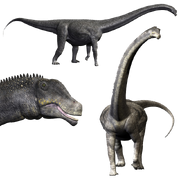
Puertasaurus is an extinct genus of titanosaurid sauropod dinosaur that lived in Patagonia, Argentina during the Late Cretaceous period. The type species, Puertasaurus reuili, is named in honor of Pablo Puerta and Santiago Reuil, who discovered the specimen in January 2001. Puertasaurus is based on a partial spinal column: a neck vertebra, a dorsal (back) vertebra, and two tail vertebrae.[1]
Anatomy[]
Restoration.
Of the four neck, back and tail vertebrae discovered, together forming the holotype MPM 10002, the largest is the back vertebra, measuring 1.06 meters (3.48 ft) tall and 1.68 meters (5.51 ft) wide. This is the broadest sauropod vertebra known, and two-thirds of its width is made up of the huge wing-like diapophyses (side processes which supported the ribs), which are heavily buttresed and merge with both the centrum and the neural spine, forming a wide spade-like shape. In most sauropods, like Argentinosaurus, they are far less large, lack buttresses, and form a simple cross-bar shape. The huge size of the diapophyses indicated a very wide rib cage, which would have been anywhere from 5 to 8 meters wide, which would make Puertasaurus not just one of the largest dinosaurs, but also possibly the widest and heaviest. The neck was also unusual; based on the single known neck vertebra, Puertasaurus had a very long, squat neck with wide cervical ribs and thick but short neural spines (unlike its relative Futalognkosaurus, whose neck was also very long, but was much deeper, with tall "shark fin" neural spines). This gave the neck a huge vertical range of motion and flexibility, and it may have been able to "bend over backwards" so that Puertasaurus could reach higher branches behind its head, without having to move its whole body - as a trade-off, the neck's sideways flexibility was more limited, though the extreme width of the neck may indicate a wide head as well, the jaws of which could take in more food per bite to make up for the lack of lateral flexibility. This strange, highly specialized squat-neck design[2] is seen nowhere else in the Dinosauria.
Length[]
Fernando Novas, one of the paleontologists who described Puertasaurus reuili, estimated that the new species was approximately 35 to 40 meters (115 to 131 ft) long and weighed between 80 and 100 metric tons (88 to 110 short tons).[3] If correct, this would place it as one of the biggest dinosaurs (and the biggest titanosaur) ever to walk the earth, though rivaled in size by the more primitive Argentinosaurus. More recent reconstructions suggest a total length closer to 30 meters.[4]
Relationships to other titanosaurs[]
Puertasaurus belonged to the clade Titanosauria.[1] Based on the shape of its known vertebrae, it is most closely related to the lognkosaurians,[5] a transitional group within Titanosauria which includes the gigantic Futalognkosaurus and the somewhat smaller Mendozasaurus, known for their hefty necks and wide rib cages, as well as similar wing-like diapophyses. If it is a lognkosaurian, Puertasaurus would be not only the largest but also the last known member of the group.
Paleoecology[]
Puertasaurus is from the Late Cretaceous Period of southern Patagonia. However, which formation it was derived from and its geological age have been disputed, because of the inconsistent stratigraphic nomenclature of southern Patagonia. It was originally reported as being from the Pari Aike Formation, and Maastrichtian in age. The Pari Aike Formation was subsequently reassigned to the Mata Amarilla Formation and reinterpreted as being from the Cenomanian to Santonian. More recent studies have stated that these deposits pertain to the Cerro Fortaleza Formation, which was dated to the Campanian or Maastrichtian (approximately 76 to 70 million years ago). The rocks of the formation mostly consist of sandstone beds, along with layers of mudstone and lignitic horizons.
The Cerro Fortaleza Formation represents a terrestrial ecosystem. The presence of paleosols and lignite suggests a humid environment with high amounts of rainfall and a high water table. Avulsion surfaces, histosols, carbonaceous fossil roots, and silicified wood all provide evidence of a low-lying forested landscape with poor drainage. Other dinosaurs from the same locality include the ornithopod Talenkauen, the theropods Orkoraptor and Austrocheirus, and the sauropod Dreadnoughtus.Non-dinosaurian fauna known from the formation include crocodilians, turtles, bony fish, and lamniform sharks.
References[]
- ↑ 1.0 1.1 Template:Cite journal
- ↑ http://paleoking.blogspot.com/2010/03/forgotten-giants-1-puertasaurus.html
- ↑ Roach, J. (2006), "Giant Dinosaur Discovered in Argentina", National Geographic News, 28 July 2006. http://news.nationalgeographic.com/news/2006/07/060728-giant-dinosaur.html, accessed 23 May 2008.
- ↑ Paul, G.S., 2010, The Princeton Field Guide to Dinosaurs, Princeton University Press.
- ↑ Template:Cite journal